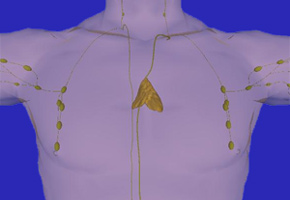

Researchers treat severe cases of primary immunodeficiency through transplantation of the small butterfly-shaped organ located near the heart
Researchers treat severe cases of primary immunodeficiency through transplantation of the small butterfly-shaped organ located near the heart.
Researchers treat severe cases of primary immunodeficiency through transplantation of the small butterfly-shaped organ located near the heart.

Researchers treat severe cases of primary immunodeficiency through transplantation of the small butterfly-shaped organ located near the heart
By Karina Toledo
Agência FAPESP – Researchers at the Duke University Medical Center in the United States are conducting experiments with transplantation of the thymus – a small butterfly-shaped organ near the heart - to treat a rare and severe form of primary immunodeficiency.
The technical details and results of the first surgeries were presented during the 2nd São Paulo School of Advanced Sciences on Primary Immunodeficiencies (ESPCA-PID) held from March 3-8, 2013, with FAPESP funding.
According to pediatrician Mary Louise Markert, who coordinated the Duke University medical team responsible for the transplant, the procedure is recommended for the most severe cases of a genetic disease known as DiGeorge syndrome, in which a baby is born without a thymus.
“The thymus functions as a school, where a very important type of defense cell - the T lymphocyte – matures and learns to protect the body against pathogens. In the complete form of DiGeorge syndrome, there are no T lymphocytes in the patient’s blood stream, which means that he or she is completely vulnerable to infections,” explained Markert in an interview with Agência FAPESP.
T cells also learn to distinguish antigens of the same organism in the thymus and not attack them. In some patients with an atypical form of DiGeorge syndrome, T cells are found in the blood stream but without the benefit of training in the thymus. Because of this, they attack their own body, causing severe inflammation in the skin and other organs.
“Through blood tests, it is possible to verify whether T cells are circulating and whether they express the CD45RA protein – an indicator that the lymphocyte has undergone maturation in the thymus. In a healthy baby, 70% of T cells should express this marker. When the exam indicates 0% or 1%, there is something very wrong with the thymus, a sign that the baby could benefit from the transplant,” says Markert.
The U.S. team has conducted the procedure in 64 children with the full form of DiGeorge and two other carriers of a mutation in the Foxn1 gene, which is characterized by the absence of the thymus and hair.
“When a cardiac surgeon operates on a baby with congenital cardiopathy, he or she needs to remove part of the thymus because this organ is right in front of the heart and is very large in newborns. Instead of discarding the tissue in the trash, they put it in a sterilized cup and inform me. Of course, this is done with the consent of the family,” explained Markert.
The donated material then undergoes a battery of exams to rule out any type of contamination. Subsequently, the cells are cultivated in a laboratory and cut into very fine strips.
“After two or three weeks, these slices are implanted into the thigh muscle of the child receiving the transplant. The procedure is like planting tulips: the surgeon opens a space between the cell muscles, places the tissue in it and covers the tissue,” she explained.
The thymus cells begin to grow in the leg, and the immature white blood cells produced in the bone marrow begin to move to this location to receive training, explained the doctor. “When you have the school, the students come. When everything works out, mature T cells can be detected in the blood stream four months after the transplant,” commented the scientist.
Among the patients operated on by the Markert team, 45 patients with DiGeorge syndrome and two carriers of Foxn1 survived. The post-transplant survival varies between 2 months and 19 years, with an average of 7.2 years.
“They have a similar lifespan as children who have the partial form of DiGeorge syndrome, who have a small thymus and do not need a transplant. They manage to attend school and do not need immunosuppressants,” commented Markert.
The researchers stressed, however, that DiGeorge syndrome could compromise other organs, such as the parathyroid gland and the heart, and these problems are not resolved with a thymus transplant.
“During embryonic development, the thymus, the parathyroid and the heart are all located in the neck of the fetus. Subsequently, the thymus and heart drop into the thorax, and the parathyroid remains in the neck. In DiGeorge syndrome carriers, something goes wrong during gestation, and these organs are affected,” commented Markert.
Tracking in newborns
The carriers of the syndrome can also have deformations of the face, kidney, and breathing apparatus in addition to neurological problems and disturbances of language and hearing. It is estimated that the disease affects 1 in every 4,000 live births. The most severe cases, characterized by the complete absence of the thymus, affect 1 in every 200,000 babies.
“The problem may be more common than we imagine. We will better understand its prevalence with the results of neonatal tracking programs,” said the doctor.
Some U.S. states have been tracking newborns for the detection of serious primary immunodeficiency diseases characterized by the absence of T cells in the blood stream since 2008. Brazil has a pilot project in São Paulo and should begin another in Minas Gerais in the second half of 2013.
Republish
The Agency FAPESP licenses news via Creative Commons (CC-BY-NC-ND) so that they can be republished free of charge and in a simple way by other digital or printed vehicles. Agência FAPESP must be credited as the source of the content being republished and the name of the reporter (if any) must be attributed. Using the HMTL button below allows compliance with these rules, detailed in Digital Republishing Policy FAPESP.





